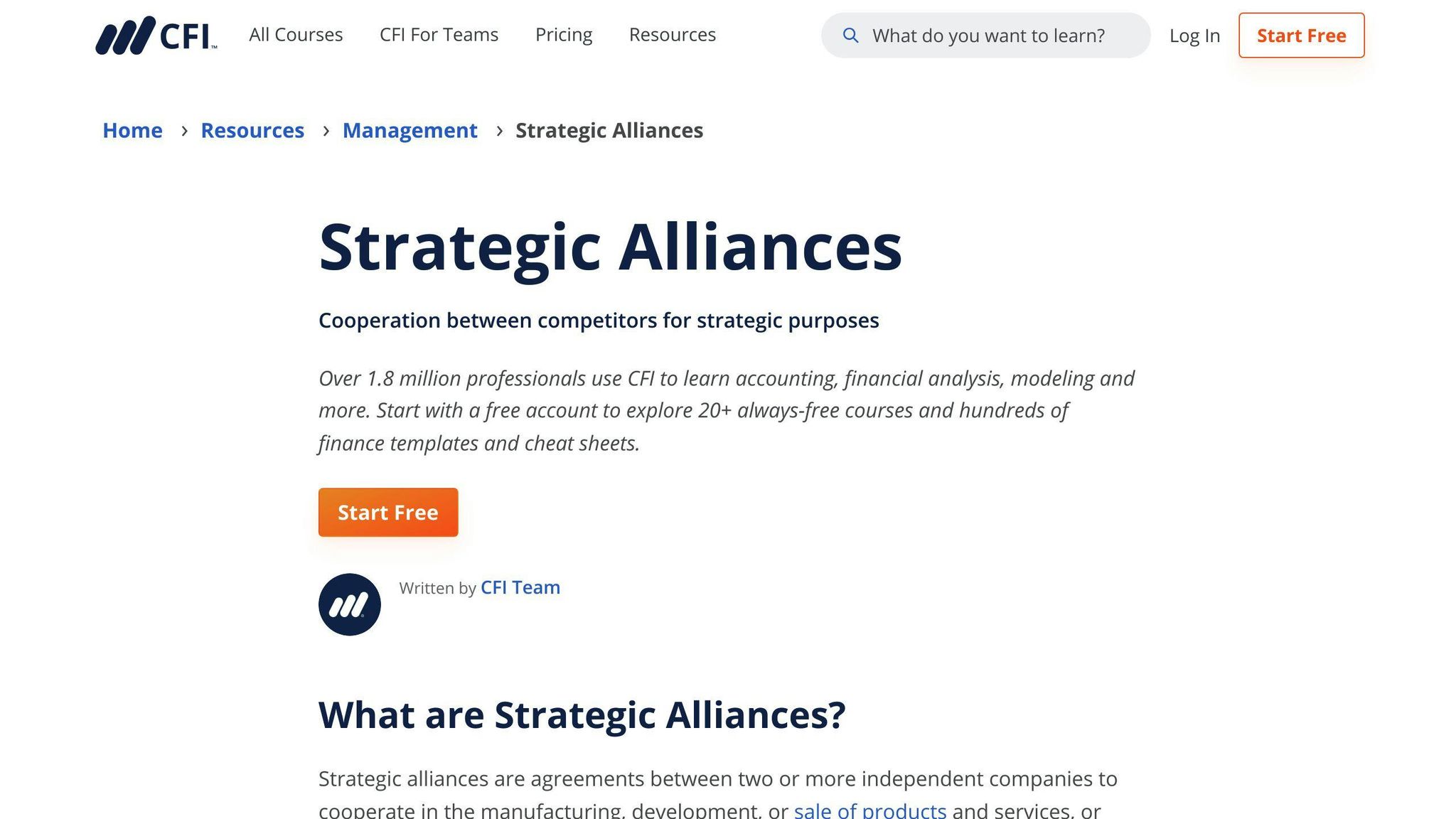Looking to grow your business and tap into new markets? Strategic partnerships might be the key. Teaming up with other companies can leverage your strengths and theirs to expand market reach, access new customers, and innovate together. Here's a quick guide to understanding, forming, and nurturing strategic partnerships:
- Strategic Partnerships: Collaborations where businesses share resources to achieve common goals.
- Types: Includes Joint Ventures, Equity, and Non-Equity Strategic Alliances.
- Benefits: Access new markets, share resources, innovate, and gain credibility.
- Finding Partners: Look for compatibility in goals, values, customer bases, and offerings.
- Forming Partnerships: Set clear objectives, research potential partners, initiate conversations, and formalize agreements.
- Managing Partnerships: Maintain communication, flexibility, and focus on mutual growth.
By choosing the right partners and focusing on shared success, strategic partnerships can propel your business into new territories and opportunities.
Types of Strategic Partnerships

Joint Ventures
A joint venture happens when companies decide to create a new business together to work on a specific project or goal. They both put in money, resources, and knowledge. How much profit or loss they share depends on how much each one has invested in this new business.
For example, if Company A and Company B start a joint venture, they might both own half of it. They'll share the costs, risks, and benefits equally.
Equity Strategic Alliances
In an equity strategic alliance, one company buys part of another company. This way, the buying company can help fund the other and, in return, gets a piece of ownership. This often means getting to use the other company's stuff, like technology, or entering new markets together.
For example, if Company X buys 20% of Company Y, Company X can use Company Y's tech to make new products.
Non-Equity Strategic Alliances
This is when companies agree to work together without buying parts of each other. They just sign a deal to share resources or capabilities to help each other out. No new company is formed, and no ownership is exchanged.
For instance, Company A might use Company B's distribution network to sell its products in new places. Company B gets more products to sell and a cut of the profits. It's a win-win without any company owning part of the other.
These types of partnerships help small businesses get things they need that they couldn't get on their own. By teaming up, they can reach new customers and grow faster.
The Benefits of Strategic Partnerships
Working together with other companies can be really helpful for businesses that want to grow and reach more people. This is called forming strategic partnerships. It means teaming up to use what each business is good at to achieve something bigger than they could on their own.
Here are some of the main good things about strategic partnerships:
Getting into New Places and Finding New Customers
- It's easier to start selling in new areas or to different types of customers
- You can use your partner's customer base and ways of selling things
- It costs less money and effort to move into new markets
Better Tools and Help
- You can do more by using what your partner has, like their skills or stuff they own
- Share the costs and risks of making new things or improving what you sell
- Work together to make more things at a lower cost
Coming Up with New Ideas and Staying Ahead
- Working together can lead to new ideas and innovations
- Use what each business is best at to make new or better products or services
- Stand out from competitors with something unique
More Trust and Getting Noticed
- Teaming up with well-known businesses can make people trust you more
- Reach more people by combining your marketing efforts
- Being seen more can help more people know about your brand
Comparison of Partnership Types
| Partnership Type | Key Benefits |
|---|---|
| Joint Venture | Getting into new areas, sharing stuff, less risk |
| Equity Strategic Alliance | More money and trust |
| Non-Equity Strategic Alliance | More freedom, sharing skills, less cost upfront |
Strategic partnerships are great because they let businesses come together and do things they couldn't do alone. By sharing what they're good at, they can grow faster and reach places or people they couldn't before.
Identifying Potential Strategic Partners
Finding the right partners for strategic partnerships can really help your business grow. It's important to choose partners carefully, focusing on how well you fit together in a few key areas:
Tips for Partner Evaluation
- Check if your products or services work well together - Ask yourself if what you both offer can be combined to better serve customers. Can you sell each other's products to your customers?
- Look into their values and reputation - Make sure you both care about the same things and run your businesses in a way that you respect. Check out what other people say about them.
- See if you're trying to reach the same customers - It's good if you both are looking to sell to similar kinds of people. This means you can help each other get more customers.
- Make sure you want the same things - It's easier to work together if you both have the same goals, like getting into new markets or creating new things.
Choosing partners who fit well with your business in these ways makes sure you can help each other grow. You can share what you're good at and reach new customers together. The best partnerships are those where everyone benefits, like being able to do more together than you could alone.
Steps to Forge Strategic Partnerships
1. Establish Clear Objectives for the Partnership
Before jumping into a partnership, first figure out exactly what you want to get out of it. Think about what you want to achieve like reaching more people, making more money, or creating new products. Ask yourself:
- Who do you want to sell to?
- What kind of help do you need from a partner?
- How quickly do you want to see results?
Knowing your goals helps you find the right partner and make sure you both can help each other.
2. Conduct Thorough Research on Potential Partners
After setting your goals, look for companies that can help you achieve them. Check things like:
- How much they know about your industry
- If their company culture fits with yours
- Who they sell to
- What they offer that you don’t have
- If they have the tech or tools you need
Make a short list of companies that match what you’re looking for.
3. Reach Out and Start Conversations
Contact the companies you’re interested in and start talking about possibly working together. Tell them about:
- What your company does
- The partnership you’re thinking of
- How both sides could benefit
If they seem interested, go into more detail about what you want from the partnership and listen to their ideas too.
4. Evaluate Compatibility and Potential for Synergy
Talk more with companies that are interested to see if you really work well together. Discuss:
- What each of you are good at and not so good at
- How you could mix your skills or resources to come up with new things
- What you could share to help each other out
- How you’ll know if the partnership is working
Look for ways you can do things together that you couldn’t do alone.
5. Negotiate and Formalize the Partnership Agreement
When you find a good match, it’s time to make it official. You should:
- Decide who does what and who gets what
- Agree on what you’re trying to do together and how you’ll check your progress
- Set up how you’ll talk to each other and share information
- Write down all the terms in a contract, including how to end the partnership if needed
Having a written agreement makes sure everyone knows what’s expected and is committed to making the partnership work.
Managing and Nurturing the Partnership
Keeping a good relationship and trust going is really important for a partnership to last and do well. Here's how to take care of your partnership and keep it strong:
Set Clear Expectations
- Make sure to have regular meetings to talk about goals, who's doing what, and how things are going.
- Have a plan for solving any problems that come up so you don't get off track.
- Agree on how and when to share important news or updates with each other.
Remain Flexible and Understanding
- Be ready to change plans if it helps both of you.
- Try to be okay with adjusting things if it makes the partnership stronger.
- When you don't agree, work together to find a solution that everyone is happy with.
Focus on Mutual Growth
- Keep looking for new ways to work together and use each other's strengths.
- Look for chances to bring in new ideas and get into new markets together.
- Share your contacts, resources, and skills to help both businesses grow.
Foster Lasting Bonds
- Work on building a good working relationship and friendship.
- Celebrate your successes together to make the partnership even stronger.
- Aim for a long-lasting relationship that goes beyond just one project or deal.
By focusing on what's best for both sides and keeping communication open and positive, partners can have a relationship that helps them do more together than they could on their own. Having trust and a good relationship makes it easier to deal with changes and find new opportunities over time.
sbb-itb-5c5ac24
Overcoming Common Challenges
Working together with another company can be great, but it's not always easy. Knowing what problems might pop up and how to avoid them can help make sure your partnership lasts and does well.
Common Partnership Challenges
Here are some issues that often come up when companies work together:
- Conflicting interests or priorities - Sometimes, partners don't agree on what they want to achieve or how to do it. This can cause arguments.
- Loss of control - When you depend on another company, you can't make all the decisions by yourself anymore. This means you need to trust them and sometimes give up a bit of control.
- Intellectual property concerns - It's important to decide who gets to keep any new ideas or products you create together. If you don't, it could lead to legal problems later.
- Poor communication - Not talking enough or sharing important information can make working together hard.
Tips to Mitigate Partnership Risks
Here's how you can avoid these problems:
- Formalize terms and processes upfront - Write down how you'll make decisions, who owns new ideas, how to solve disagreements, and how to end the partnership if needed.
- Institute regular status meetings - Having regular meetings helps everyone stay on the same page and avoid surprises.
- Remain flexible - Be open to changing your agreement if it makes the partnership stronger.
- Focus on mutual goals - Remember what you both want to achieve together and how each side benefits.
By planning ahead, talking often, and being willing to adjust, you can work through challenges and have a successful partnership.
Real-World Examples of Successful Strategic Partnerships
Starbucks and Spotify
In 2018, Starbucks, a coffee shop chain, teamed up with Spotify, a music streaming service, to make visiting Starbucks a better experience. Spotify put together special playlists that fit the Starbucks vibe and played them in the stores.
This partnership brought a few big wins:
- Customers enjoyed a better atmosphere with music that matched the Starbucks feel.
- Spotify got its music in front of more people who hang out at Starbucks.
- Starbucks stores became a nicer place to be, encouraging customers to stay longer.
By working together, Starbucks and Spotify used what each does best to make going to Starbucks more fun and personal for customers, helping both companies.
Uber and Spotify
In 2015, Uber, a company that lets you book rides through an app, and Spotify, also got together. This deal let people who use Uber play their own Spotify playlists during their rides.
Here's what came out of this partnership:
- Riders had a better time because they could listen to their own music.
- People who rode with Uber were happier with their rides.
- Spotify got its music app used by more people through Uber.
Uber and Spotify connected their tech to offer something new. Letting riders pick their music made Uber stand out from other ride services. This was good for both Uber and Spotify, making them more popular and liked by customers.
Conclusion
Working together with other companies, or strategic partnerships, is a smart way for businesses to grow and reach more people. By teaming up, companies can use each other's strengths, like know-how, tools, and connections, to grow faster and in a smarter way.
Here's why teaming up can be really helpful:
- Quickly move into new areas or find new customers: By joining forces, you can easily start working in new places or with different kinds of customers using your partner's already established network.
- Use what your partner has: You can get access to tech, ideas, or even buildings that might be hard or expensive to get on your own.
- Make your products or services better: Working together can help you come up with new or improved offerings that attract more customers.
- Get noticed and trusted more: Teaming up with a company that's already well-known can make more people pay attention to you and trust what you offer.
- Split the costs and risks: Sharing the expenses and risks with a partner makes trying new things less scary and costly compared to doing it all by yourself.
The trick is to find partners that really match your goals and way of doing things, make fair agreements, and keep a good relationship to get the most out of working together. With the right planning and effort, strategic partnerships can bring together what each company does best for the benefit of both.
For small businesses and startups looking to reach more people, thinking about teaming up with other companies could be a smart move. Getting advice from someone who knows a lot about this, like a Fractional CMO, can help figure out if this is a good idea and how to make it work. If you think teaming up could help your business grow, it might be worth reaching out to see what's possible.
Related Questions
What are the 4 stages of strategic partnership?
The 4 main stages of building strategic partnerships are:
- Figure out what your business wants to achieve
- Look for other companies that could help you reach those goals
- Start talking to those companies to see if you work well together
- Agree on how you'll work together and put it in writing
How do strategic alliances increase market share?
Strategic alliances can help you reach more customers in several ways:
- Get into new places by using a partner's customer list or ways of selling
- Find new customers by advertising together
- Create new or better things to sell by joining forces
- Save money by sharing costs
Working with another company lets you do more than you could on your own.
How do you strengthen strategic partnerships?
To make strategic partnerships stronger:
- Be clear about what you both want to achieve from the start
- Talk often to make sure everyone is on the same page
- Be willing to change plans if it helps both of you
- Keep focusing on what you both want to get out of the partnership
- Build trust and get to know each other better
Good partnerships need both sides to work together and be open with each other.
What is strategic marketing partnership?
A strategic marketing partnership is when two companies work together to help each other with marketing. They share ideas, resources, and connections to reach goals they couldn't on their own.
The main benefits are reaching more people, using new ways to sell, sharing the costs, and helping both companies grow.



